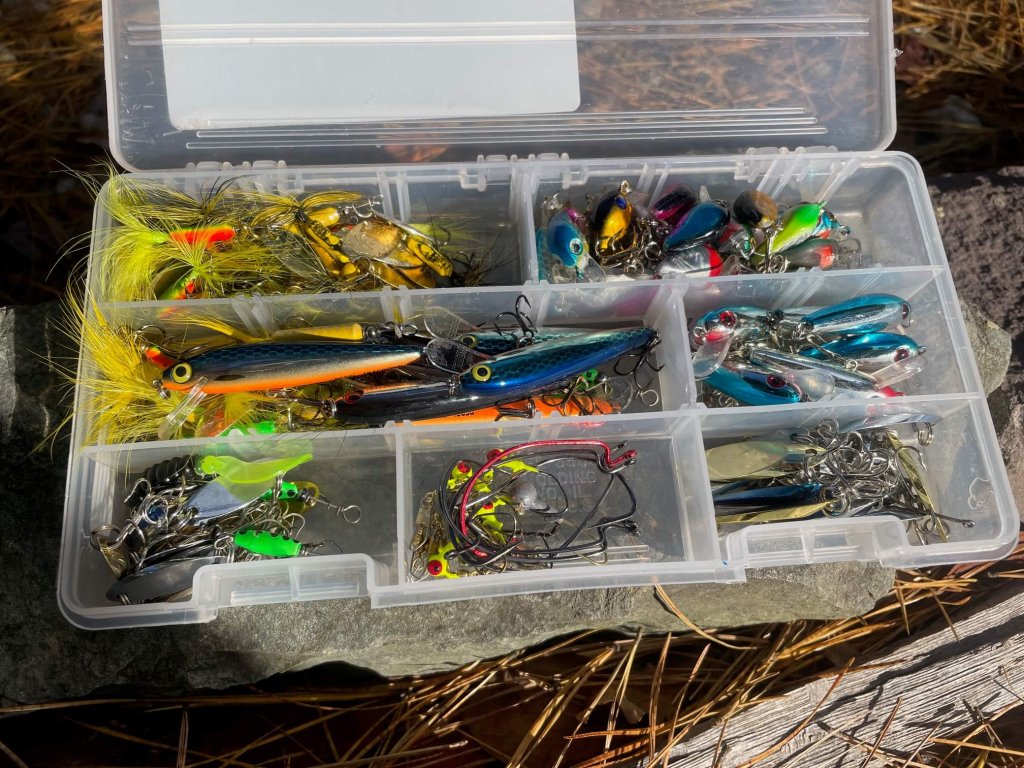
“Many men go fishing all of their lives without knowing that it is not fish they are after.” ~Henry David Thoreau
While they differ in their preferences in terms of habitat and forage, trout are still predatory fish, and the techniques that make one predatory fish bite more often than not will work on another.
That being what it is, it is still the case that there are some types of lures, along with techniques, that are particularly effective at targeting some species.
In the case of trout fishing, three of the most effective classes of lures are spoons, in-line spinners, and plugs, which some anglers refer to as trout minnows.
This post will break down these three effective trout fishing lures, some specific patterns that are especially effective, and how to use them.
In-line Spinners
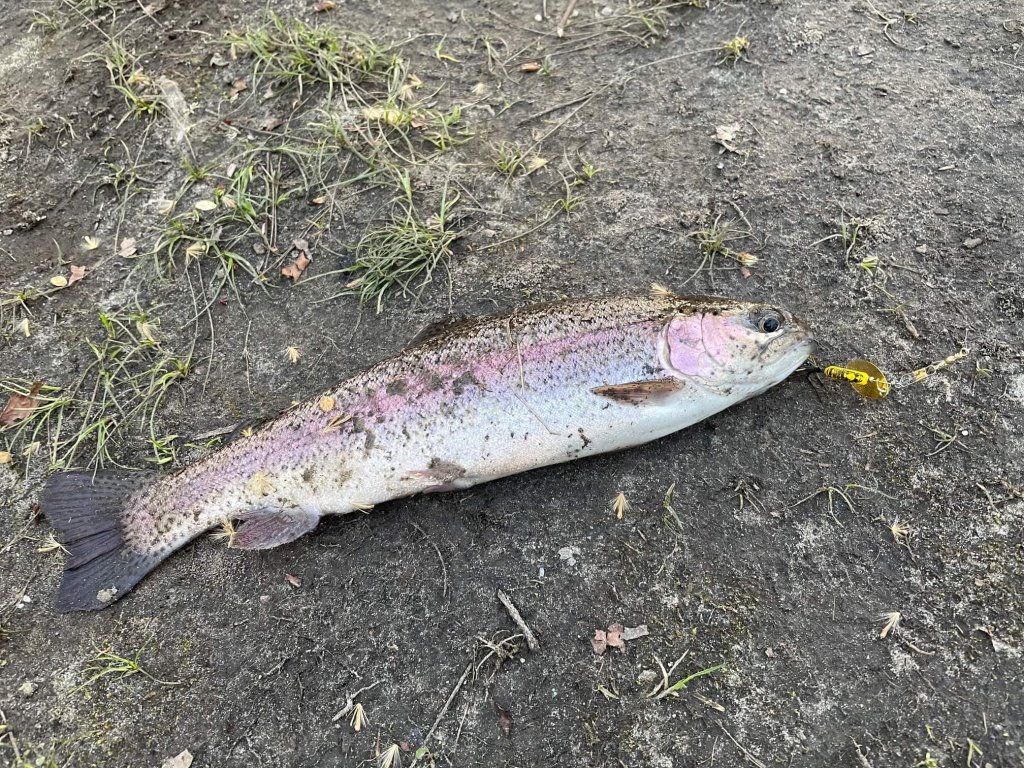
In-line spinners, which consist of a wire frame, a lead, plastic, brass, or glass body, and a spinner blade either directly attached to the wire shaft or attached via a clevis, are probably the most effective trout lures, hands-down.
Trout spinners are among the most effective trout lures simply because they catch fish. But on top of that, you “search” with a spinner much more quickly and effectively than with other lures, casting and retrieving to multiple bits of structure or pockets of water in a small fraction of the space of time it would take you to plumb them with the other lures that will be mentioned here.

In-line spinners are also effective because they appeal to a trout’s predatory instincts on two grounds: sight and sound. Both the vibration and flash of a spinner often prove deadly effective on trout and will often work when other techniques fail.
The other great thing about trout spinners is that they are by far the easiest type of trout lure to learn to use – just cast and retrieve. They are the only type of lure that routinely catches fish on a straight retrieve, without a stop-and-go cadence (though that can also be used.
Some effective trout fishing lures that have worked for me (from my personal experience) are:
Mepp’s Aglia spinners (Size 0-2)
Rooster Tail spinners (⅙ to ⅛ ounce)
Rooster Tail Vibric spinners
Blue Fox Whiptail spinners
Blue Fox Deep Runner spinners
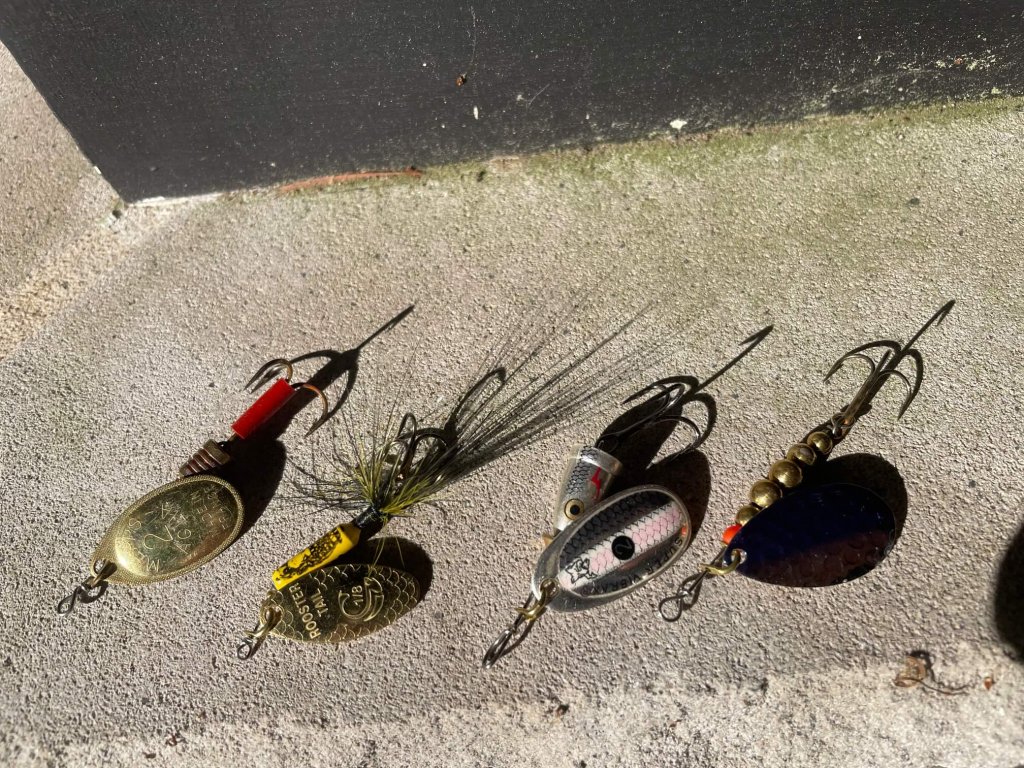
Other trout spinners that are also popular include:
Blue Fox Vibrax spinners
Panther Martin spinners
Joe’s Flies spinners
Thomas spinners
These are just a few of the common popular trout spinners on the market; there are others. I also make my own trout spinners in a variety of patterns, but I prefer a very small French blade that keeps the overall profile of the spinner small. For some reason, it’s not uncommon to catch fairly big trout on small lures.
Keep in mind that spinner blade pattern will influence how quickly or slowly the lure can be worked, as well as how easy it will be to maintain a position in the water column.
Spinners with willow leaf blades will need to be run at a faster speed to keep the blade turning, but they also tend to rise less quickly, making it easier to fish them deeper. On the flipside, spinners with wider, flatter, deeper blades, like French blades and Colorado blades will run true at very low speeds, which can make them effective in very shallow water.
How to Fish Trout Spinners
Besides the fact that they are deadly effective on trout, spinners are popular because of how easy and straightforward they are to fish. Someone that has literally never fished a day in his life could pick up a spinner, cast it, and catch a fish in a matter of minutes.
You just cast and retrieve; that’s the basic trout spinner technique. A few things I have noticed are that, as a general rule, run the spinner as slowly as the conditions will allow, and that you should also work the spinner downstream as opposed to upstream if you can help it.
Of course, running a lure quickly does occasionally work, but in my experience, running it as slowly as possible to keep the blade turning is most effective. Maybe it gives the lure more hang time and the fish more time to think about it.
Also, working the lure downstream as opposed to upstream give you better control over depth and presentation (a spinner run upstream will ride high in the water column) and bringing it downstream also produces a more natural presentation. Trout naturally orient themselves facing upstream, waiting for bait to drift by.
It’s highly effective to “search” bits of structure with a trout spinner. Cast to overhangs, deep pockets, drop offs, cuts in the bank, the edges of eddies and riffles, rocks, logs, and downed trees in the water. These are the places trout shack up and out of which they will explode on a delicately presented lure.
Spoons
Spoons, like spinners, are also extremely effective trout fishing lures. In fact, I would even argue that, for multiple reasons, spoons are much more versatile than trout spinners.
This is because spoons can be run at both high and low speeds, without worrying about the blade not turning. Most quality spoon patterns will wobble consistently at both fast and slow retrieves.
Spoons also produce flash, like spinners, along with vibration, but they are a lot less loud. This makes the presentation of a spoon a lot more subtle. When trout are responsive to flash but the aggressive thump of spinners makes them skittish, a spoon can be more effective.
For instance, if you see trout charging or short striking your spinners, but not committing, try switching over to a spoon and see if that works. More than once I’ve had trout rush at spinners, then switched to a spoon and forced a more committed strike.
Like trout spinners, there are many spoons that are highly effective on trout. Some of my personal favorites are:
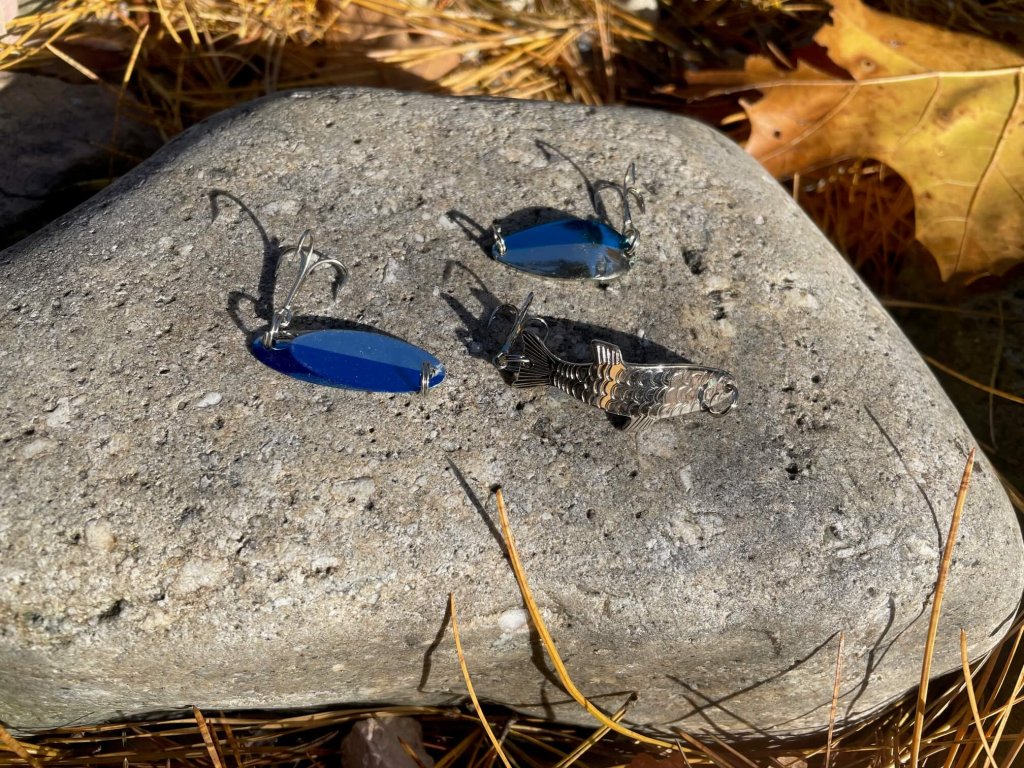
Acme Kasmasters (⅛ ounce models, sometimes ¼ ounce, but that’s fairly big)
South Bend Kast-A-Way spoons (⅛ ounce, like a Kastmater but more affordable and the trout don’t know the difference)
Acme Little Cleo (⅙ ounce)
Acme Phoebe (⅛ ounce)
Other trout spoons that can be effective are:
Johnson Silver Minnows
Luhr-Jensen Krocodile spoons
Eppinger Dardevle spoons
Cotton Cordell CC spoon
Again, there are many other effective trout spoon patterns; these are just some of the better ones I know of.
How to Fish a Spoon for Trout
As a general rule, the same notes apply for presentation of trout spoons as they do for spinners; work the spoon downstream at a clip slightly faster than the current, and cast to structure.
But other than that, there are lots of techniques and cadences that can be used with a spoon. The least effective, in my estimation, is the straight retrieve. Cast upstream or to structure, then steadily crank the reel handle to bring the spoon back slowly. It will wobble from side to side, throwing flash and vibration that are attractive to trout.
However, as I said, this is the least effective technique and more erratic cadences tend to produce more fish. One of the simplest is to cast upstream or to structure, then to twitch the rod tip as you retrieve the spoon. This will make the spoon rise and flutter, and dart from side to side as it comes back to you. This imitates a dying minnow that will be erratically sputtering about in throes, which is utterly irresistible to predatory fish. Don’t be surprised if you catch a few pickerel, bass or panfish among your trout with this technique, they all love it.
If the water’s deep enough, you can jig or yo-yo the spoon back to you. Cast, let the spoon drop, then raise the rod tip and give the reel a few cranks. This will cause the spoon to rise rapidly before fluttering on the drop – and the drop is where you will get most hits, trust me.
Jigging also works, though it is best done vertically, from a boat (it’s hard to jig from shore). Just drop the spoon down, then raise and lower the rod tip rhythmically to get the lure to rise and then flutter down through the water. Again, the drop is where you’ll get most strikes.
When trout are very aggressive (which is not very common) you can cast to structure and then rip the spoon back to you, high in the water column, almost at the surface. This imitates a fleeing baitfish and can be highly effective. Just don’t run the spoon too fast or it will spin instead of wobble. A spinning spoon will still catch fish, but it will also cause a hell of a lot of line twist.
Plugs (Trout Minnows)
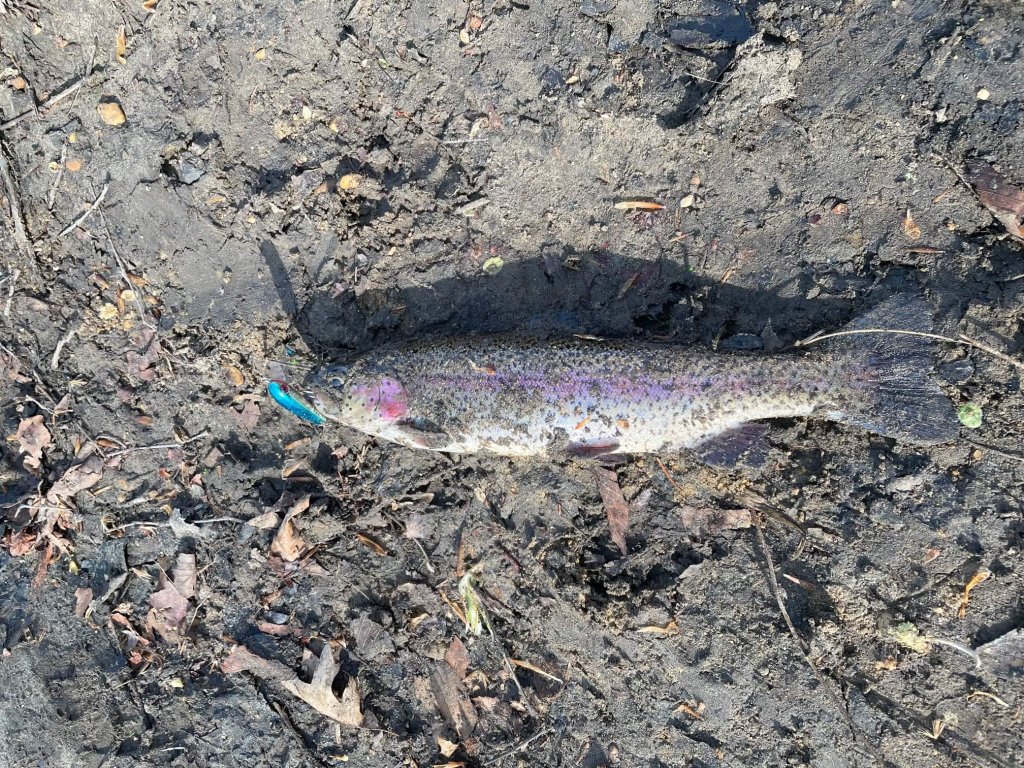
As effective as trout spinners and spoons are (and they are, I’ve caught the vast majority of the trout I’ve caught on metals) plugs can also be highly effective and they’re also by far the most versatile of all trout fishing lures.
Your basic plug is a piece of plastic or wood that’s carved into the shape of a fish, or in somewhat rarer cases, an insect or crawfish, although those patterns are usually reserved for bass and panfish. A trout plug, also called a trout minnow, may have a lip, in which case it will dive, or it may be lipless. Plugs may either be buoyant, diving when retrieved and then floating back to the surface when paused, or they may sink slowly. Some plugs, like the Rapala Husky Jerk, are neutral buoyancy, meaning they remain where they are in the water column when paused.
There are tons and tons of trout minnows that are highly effective on trout. Some of my favorites include:
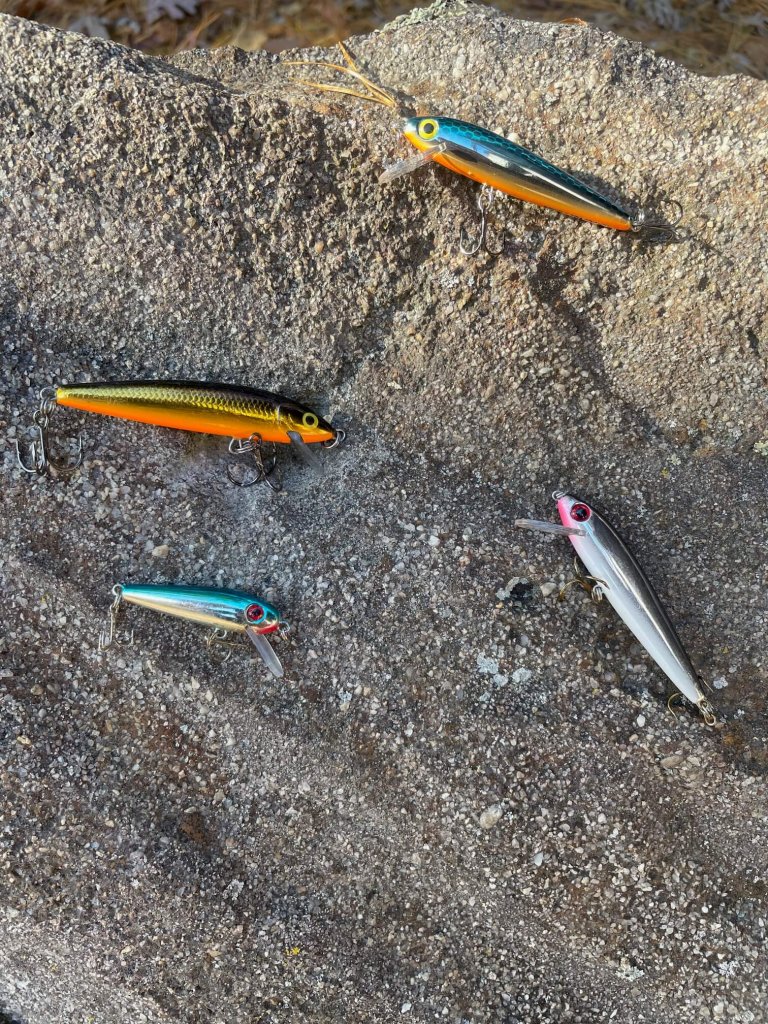
Creme Ultra-Lite Jerkbait
Rebel Value Series Minnow
Rebel Tracdown Minnow
Rapala Husky Jerk
Of these, I have to say I think the Creme Ultra-Lite Jerkbait is the best. There are a few reasons for this. It has great action, it’s very tiny, and it doesn’t dive too deep. It’s also slightly buoyant, so moderating the retrieve, it can be used in extremely shallow water. The other thing is it’s just absurdly cheap. You can get them for a dollar and change at Wal-Mart; Bass-Pro and Cabela’s also sell them for less than 2 dollars each. You just can’t beat the Creme Ultra-Lite Jerkbait for the price.
I will admit that in terms of sheer realism, the Creme is a lot cheaper in look and feel than a Rapala, and the hooks won’t last nearly as long, but in terms of abject fish-catching abilities yoked to a ridiculously low price, you just can’t beat it.
Other great trout minnows include:
Rapala Original Floating Minnow
Rebel Tracdown Ghost (barbless hooks)
Yo-Zuri Pins Minnow
There are many others, but these are some of the best with which I am familiar.
How to Fish Trout Minnows
The big thing about trout minnows is that they’re versatile, much more so than both spinners and spoons. Spinners and spoons both sink; there are trout minnows that sink as well as those that exhibit neutral buoyancy. How you fish a plug is a matter of pattern and choice.
Like trout spinners and spoons, trout minnows can be fast to structure, and it’s also highly effective to cast them upstream and work them downstream at a slow clip. You can also cast them across the current and work them sluggishly back, like an injured or disoriented baitfish. This approach can be highly effective.
Like a trout spinner or spoon, the most basic way to fish a trout minnow is to cast and then run a slow, straight retrieve. Doing so, the minnow will wobble from side to side, producing visual and auditory attraction through the vibrations it emits. The straight retrieve can produce, but again, and as with spoons, I find it is the least effective technique.
One of the most effective ways to work a trout minnow, regardless of where you present it, is to slow twitch it back to you. Cast and then give the rod tip a few short pops or jerks, then let the lure pause. Whether it stops where it is, floats slowly back up, or sinks, it’s on the pause where you’ll mostly get bitten.
Another more aggressive technique is known as slashing or jerking. Cast, then let the lure pause for a second before slashing the rod tip sharply to the left or right. This will cause the minnow to dart back and forth in the water. Again, most of the strikes you get will be on the pause.
In deeper water, with a sinking plug, you can cast, let the lure sink for a few seconds, then pop the rod tip sharply up. This will cause the plug to jerk upwards in the water column, before slowly beginning to sink again. This action is very like that of a dying and disoriented minnow that has drifted from cover. It can be highly effective on aggressive trout. In this case as in others, the strike will usually come on the pause or drop.
One more note is that, while trout are generally not affected by cold water in the way that warmwater species like bass and bluegill are, the aggressiveness of your cadence should match the water temperature. Try a slower, more metered technique in very cold water, and be a little more aggressive and quicker with your retrieve in water that is cool rather than cold.
While this is not a comprehensive treatise on how to fish a trout minnow, the techniques featured here are more than enough to get you started and are proven to catch trout. Try some of them out the next time you get a chance.
You Miss 100% of the Fish You Don’t Cast to
All in all, I’ve covered enough specific trout spinner, spoon and minnow patterns, for you to pick out a few, round out your tackle box and try something new. Also, I want to disclaim that there are many other techniques that I have not covered here – but those I have selected have worked for me and other trout anglers I’ve spoken to. Try some of them out when you get a chance and make a mental file of what works for you.
Tight lines.
~The Eclectic Outfitter
